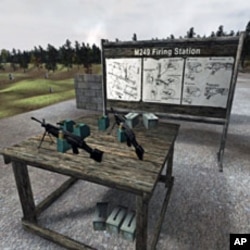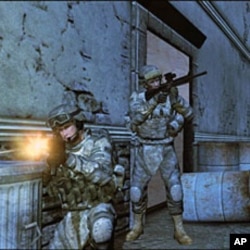PC Gamers – from dungeon-crawlers and dragon slayers to all-out World of WarCraft fanatics – are often dismissed as being out of touch with reality. But the allure of PC games and their ability to engage and transfix have become a powerful recruitment and training tool.
These dedicated gamers caught the eye of the US Army in the 1990s when it first realized that the long hours spent in virtual gaming worlds could be an ideal medium to introduce potential young recruits to the military and help train them.
That was when the idea for America’s Army was born.
“I don’t think there’s any question that the intention of the game is [to] provide information about soldiering and army values,” said America’s Army Program Manager Frank Blackwell. “And there’s no question that that has been a success.”
America’s Army is one of the Internet’s most popular games, with more than 11 million registered users around the world.
Andrew Bostock, a British gamer, says America’s Army opened his eyes to what a military career would entail.
“There is no better way to reach young recruits than to show them, in a world which they are accustomed to seeing and participating in,” Bostock said.
The game has built-in modules to immerse players in virtual training scenarios before they enlist.
“We tried to put some real first-aid training into [the game],” said Blackwell. “And we’ve had two cases that we know of where young people have been able to, in emergency situations, save lives and [have] attributed those skills back to what they learned in that training.”
Other modules train players on various weapons systems using enhanced graphics and realistic environments. The more realistic the graphics, says Blackwell, the better the training.
But there are concerns in some military circles and think tanks that virtual training might be edging out real-world training.
“I am a proponent of this sort of thing,” says Michael O’Hanlon, a national security and defense policy expert at The Brookings Institution, “but I don’t believe it can ever or should ever replace other kinds of training."
But Blackwell is quick to point out that virtual training is not intended to replace real-world training, but to complement it, giving soldiers the opportunity to supplement their training much more cheaply.
Beyond costs savings, Michael O’Hanlon says virtual training also helps save lives.
“You don’t have to spend as much money on the equipment, on wear-and-tear, on fuel, etc.,” he said. “Also, you might be able to be safer perhaps. Before you send someone to operate a real vehicle or operate in a real tactical setting, you try to get them used to the circumstances they are going to face on a simulator or a computer game where there’s no danger of being hurt if they make a mistake,” O’Hanlon added.
On the other hand, some military experts worry that virtual training blurs the line between video games and war for impressionable young recruits who might mistake their first combat engagement as a first-person shooter. In a computer game, if a player gets his avatar or PC character killed, all he has to do is reload a saved game and start again.
In a real life, there are no reloads.
“America’s Army is actually relatively sanitized on purpose,” says Professor Joseph Delappe of the University of Nevada. “They’ve designed it I think in a way where there is very little bloodshed, in fact, so that any child 15 years or older can download it and access the game without any parental permissions or controls.”
Delappe, who is also a media artist and activist, sees a disconnect between the death and mayhem of war and game warfare. Every time he plays the game, he intentionally kills off his character and resurrects it as part of a project to honor America’s fallen in Iraq and Afghanistan and draw attention to the gruesome reality of war.
“You don’t have heads blowing off and bodies exploding [in America’s Army] like you do in many of the other sorts of first-person shooters,” said Delappe. “But that’s kind of part of their marketing genius and part of the sort of insidious nature of the game.”
But the idea behind training in America’s Army’s safe environment is to avoid blowing up body parts and help soldiers survive real battles. And that is the premise for a whole new breed of games that teach a different kind of warrior - those who wage peaceful resistance or fight natural disasters.
That was why the International Center on Nonviolent Conflict in Washington, D.C. created two turn-based strategy games - A Force More Powerful and the more recent People Power .
“People who were interested in waging nonviolent struggle in any number of countries around the world really needed some help,” said Steve York, producer of People Power. “…How do you develop a strategy when you’re fighting against corruption, dictatorship, various forms of authoritarian oppression?” He asked.
Unlike America’s Army, People Power isn’t about entertainment. It uses a game-like interface to empower users, allowing them to be strategists and organizers of nonviolent opposition movements. The ultimate goal is for players to share experiences and game scenarios online.
York cited the case of a Serbian game designer who used his experience resisting Slobodan Milosovic's regime to help develop People Power. “[The] experiences that you have in a real-life struggle... will be useful to other people who are involved in similar, never identical, struggles."
The Middle East conflict is the subject of Peacemaker, a game of diplomacy and peaceful mediation.
Players exploring Darfur Dying try to save refugees in Sudan’s western Darfur region from present dangers; a new game being created by the US Federal Emergency Management Agency (FEMA), called Disaster Hero, will help people cope with and survive various disasters.
And that is just the beginning. Steve York says the exciting potential of the gaming platform as an educational tool is just being discovered.
“The type of learning that’s involved when someone plays a game in an interactive format like on a computer - [that] type of learning is known in the field as experiential learning,” York explained. “It’s not the same as the more didactic kind of learning that takes place in classrooms where there are lectures and textbooks and so forth. It’s learning by doing. It’s learning from experience,” he concluded.
If the success of America’s Army is any indication, then teaching through gaming is likely to become as prevalent - and perhaps as controversial.









